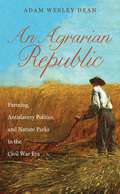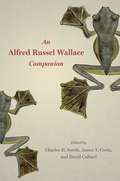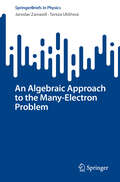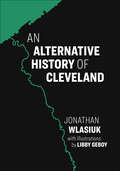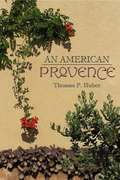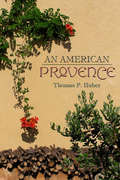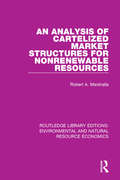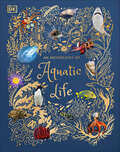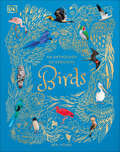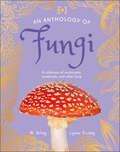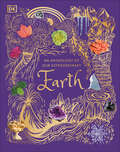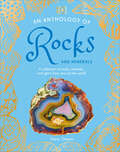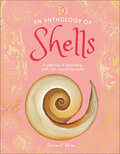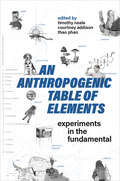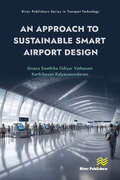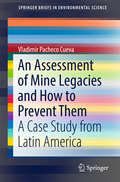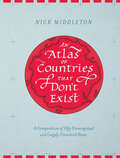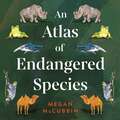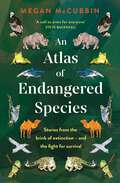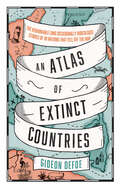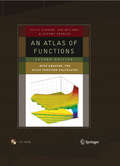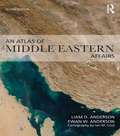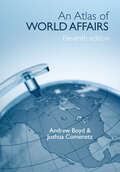- Table View
- List View
An Agrarian Republic
by Adam Wesley DeanThe familiar story of the Civil War tells of a predominately agricultural South pitted against a rapidly industrializing North. However, Adam Wesley Dean argues that the Republican Party's political ideology was fundamentally agrarian. Believing that small farms owned by families for generations led to a model society, Republicans supported a northern agricultural ideal in opposition to southern plantation agriculture, which destroyed the land's productivity, required constant western expansion, and produced an elite landed gentry hostile to the Union. Dean shows how agrarian republicanism shaped the debate over slavery's expansion, spurred the creation of the Department of Agriculture and the passage of the Homestead Act, and laid the foundation for the development of the earliest nature parks.Spanning the long nineteenth century, Dean's study analyzes the changing debate over land development as it transitioned from focusing on the creation of a virtuous and orderly citizenry to being seen primarily as a "civilizing" mission. By showing Republicans as men and women with backgrounds in small farming, Dean unveils new connections between seemingly separate historical events, linking this era's views of natural and manmade environments with interpretations of slavery and land policy.
An Alfred Russel Wallace Companion
by Charles H. SmithAlthough Alfred Russel Wallace (1823–1913) was one of the most famous scientists in the world at the time of his death at the age of ninety, today he is known to many as a kind of “almost-Darwin,” a secondary figure relegated to the footnotes of Darwin’s prodigious insights. But this diminution could hardly be less justified. Research into the life of this brilliant naturalist and social critic continues to produce new insights into his significance to history and his role in helping to shape modern thought. Wallace declared his eight years of exploration in southeast Asia to be “the central and controlling incident” of his life. As 2019 marks one hundred and fifty years since the publication of The Malay Archipelago, Wallace’s canonical work chronicling his epic voyage, this collaborative book gathers an interdisciplinary array of writers to celebrate Wallace’s remarkable life and diverse scholarly accomplishments. Wallace left school at the age of fourteen and was largely self-taught, a voracious curiosity and appetite for learning sustaining him throughout his long life. After years as a surveyor and builder, in 1848 he left Britain to become a professional natural history collector in the Amazon, where he spent four years. Then, in 1854, he departed for the Malay Archipelago. It was on this voyage that he constructed a theory of natural selection similar to the one Charles Darwin was developing, and the two copublished papers on the subject in 1858, some sixteen months before the release of Darwin’s On the Origin of Species. But as the contributors to the Companion show, this much-discussed parallel evolution in thought was only one epoch in an extraordinary intellectual life. When Wallace returned to Britain in 1862, he commenced a career of writing on a huge range of subjects extending from evolutionary studies and biogeography to spiritualism and socialism. An Alfred Russel Wallace Companion provides something of a necessary reexamination of the full breadth of Wallace’s thought—an attempt to describe not only the history and present state of our understanding of his work, but also its implications for the future.
An Algebraic Approach to the Many-Electron Problem (SpringerBriefs in Physics)
by Jaroslav Zamastil Tereza UhlířováThis book presents an algebraic approach to the coupled cluster method for many-electron systems, pioneered by Josef Paldus. Using field methods along with an algebraic, rather than diagrammatic, approach facilitates a way of deriving the coupled cluster method which is readily understandable at the graduate level. The book begins with the notion of the quantized electron field and shows how the N-electron Hamiltonian can be expressed in its language. This is followed by introduction of the Fermi vacuum and derivation of the Hartree-Fock equations along with conditions for stability of their solutions. Following this groundwork, the book discusses a method of configuration interaction to account for dynamical correlations between electrons, pointing out the size-extensivity problem, and showing how this problem is solved with the coupled cluster approach. This is followed by derivation of the coupled cluster equations in spin-orbital form. Finally, the book explores practical aspects, showing how one may take advantage of permutational and spin symmetries, and how to solve coupled-cluster equations, illustrated by the Hubbard model of benzene, the simplest quasi-realistic model of electron correlation.
An Alternative History of Cleveland
by Jon WlasiukDive into Cleveland&’s deep past and return with a new vision for how we should think about the region today. The land we call &“northeast Ohio&” was originally forged through eons of glacial pressure, geologic shifts, and the relentless movement of the Cuyahoga River. Since the last Ice Age, however, it has also been transformed countless times by the many people who have called it home. In An Alternative History of Cleveland, Jon Wlasiuk uncovers the mysteries, devastations, and human incursions that have shaped the region. Here, you&’ll encounter the giant megafauna that roamed the area until their mysterious extinction, Indigenous civilizations who first shaped the land and harnessed its natural resources, industrial pioneers like John D. Rockefeller and Charles Brush who corralled electricity and crude oil in the service of capitalist progress, the environmental devastation that polluted the Cuyahoga and caused toxic algae blooms in Lake Erie, and the numerous Clevelanders today who want to reshape the city&’s relationship with the natural environment. Though separated by thousands of years, these stories contain a common theme: the city of Cleveland remains bound to nature, despite our best efforts to liberate ourselves from its limits. Part natural history, part archeological essay, and part a contemporary call to arms to reclaim and rewild Cleveland&’s future, this unforgettable trek into the heart of &“the Land&” will change the way you see the city forever. Praise for An Alternative History of Cleveland: "A stunning accomplishment." —Dr. John Grabowski, editor, Encyclopedia of Cleveland History "Wlasiuk is a dazzling storyteller, weaving the threads that connect ancient swamps to the Agora, or giant sloths to Public Square, all in the service of illuminating the inextricable tether we have to the plants, animals, and waterways around us." —Raechel Anne Jolie, author of Rust Belt Femme"I read Jon Wlasiuk&’s marvelous deep-time history of Cleveland with a sense of awe. A story of place that&’s this well-done, this accessible to the public, and with this sort of fascinating arc through time is going to rearrange the furniture in every reader&’s head." —Dan Flores, New York Times best-selling author of Wild New World and Coyote America
An American Provence
by Thomas P. Huber"I have talked about luscious wines and succulent fruit and exquisite dinners. But there may be no more evocative experience of the two valleys than the smell of new-mown hay in the fields at dusk. If a person were to close their eyes, they could not tell if they were in Provence or the North Fork Valley. That sweet, earthy odor is part of the beauty of these places." -From An American Provence In this poetic personal narrative, Thomas P. Huber reflects on two seemingly unrelated places-the North Fork Valley in western Colorado and the Coulon River Valley in Provence, France-and finds a shared landscape and sense of place. What began as a simple comparison of two like places in distant locations turned into a more complex, interesting, and personal task. Much is similar-the light, the valleys, the climate, the agriculture. And much is less so-the history, the geology, the physical makeup of villages. Using a geographer's eye and passion for the land and people, Huber examines the regions' similarities and differences to explore the common emotional impact of each region. Part intimate travelogue and part case study of geography in the real world, An American Provence illuminates the importance sense of place plays in who we are.
An American Provence
by Thomas P. Huber"I have talked about luscious wines and succulent fruit and exquisite dinners. But there may be no more evocative experience of the two valleys than the smell of new-mown hay in the fields at dusk. If a person were to close their eyes, they could not tell if they were in Provence or the North Fork Valley. That sweet, earthy odor is part of the beauty of these places." -From An American Provence In this poetic personal narrative, Thomas P. Huber reflects on two seemingly unrelated places-the North Fork Valley in western Colorado and the Coulon River Valley in Provence, France-and finds a shared landscape and sense of place. What began as a simple comparison of two like places in distant locations turned into a more complex, interesting, and personal task. Much is similar-the light, the valleys, the climate, the agriculture. And much is less so-the history, the geology, the physical makeup of villages. Using a geographer's eye and passion for the land and people, Huber examines the regions' similarities and differences to explore the common emotional impact of each region. Part intimate travelogue and part case study of geography in the real world, An American Provence illuminates the importance sense of place plays in who we are.
An Analysis of Cartelized Market Structures for Nonrenewable Resources (Routledge Library Editions: Environmental and Natural Resource Economics)
by Robert A. MarshallaOriginally published in 1979. While the theory of non-renewable resources under competitive and monopolistic market regimes have been relatively well developed, almost no attention has been given to the development of a theoretical framework for analysis of the spectrum of mixed market structure between those extremes. The world oil market structure is an example of such an intermediate market structure. The purpose of this title is to develop such a theoretical framework. The study examines non-renewable resource markets in which a profit maximizing producer cartel co-exists with a non-cartel supply sector, which is alternately modelled as consisting of a collection of competitive firms or as exhibiting other exogenously assumed supply behaviours. This title will be of interest to students of environmental economics.
An Anthology of Aquatic Life (DK Children's Anthologies)
by Sam HumeDive into the wondrous world of water and discover the stories of more than 100 incredible aquatic lifeforms.The underwater world is so much bigger than young minds can fathom and there is always more to learn. An Anthology of Aquatic Life is a stunning ocean encyclopedia for young readers to explore, with reference pages packed with fascinating information, little learners will be captivated as they discover the facts, stories and myths behind their favourite sea-life animals. From the deepest, widest ocean to the tiniest puddle, this beautiful compendium takes young readers on an enthralling journey through the aquatic world, meeting amazing animals, ingenious plants, and much more along the way. Stunning photography and gorgeous illustrations complement storybook descriptions about each lifeform, and children can uncover hundreds of fascinating facts as they read. Did you know that elephant seals can hold their breath underwater for more than an hour, or that the brown basilisk reptile can run across water? Discover the science of how plants have learnt to live, feed, and breathe in water, and take a look at the unique challenges of distinct ecosystems on feature spreads about rivers, lakes, wetlands, and more. Celebrate your child&’s curiosity as they:- Explore detailed photographs and striking illustrations of nature in action- Reveal fun facts and myths about how a range of animals and plants adapt to their environments- Uncover more than 100 aquatic lifeforms, each with stunning images and captivating information.This ocean encyclopedia for children is the perfect blend of storybook style text with out of this world illustrations which makes it a fantastic sea life book for children who are obsessed with the underwater world. Encourage young readers to go on a journey to explore a world of information, making this the ideal first reference book for kids aged 7-9 to enjoy for hours on end, whether reading with the family or reading alone, this fun fact book also doubles up as the perfect gift for curious kids who love to learn. Explore the diversity of the animal kingdom whilst uncovering: -Stunning Jacket Detail: gold foil, holographic foil & metallic gold edges-Stunning photography & illustrations inside-A beautiful book for the whole family to treasure -A quality gift to be passed down through the generationsMore in the SeriesAnthology of Aquatic Animals is part of the beautiful and informative Anthology series. Complete the series and nurture your child's curiosity as they explore the natural world with The Wonders of Nature or let them walk with the dinosaurs who ruled the earth before them in Dinosaurs and other Prehistoric Life.
An Anthology of Exquisite Birds (DK Children's Anthologies)
by Ben HoareSoar through the sky with best-selling author Ben Hoare and discover some of the most exquisite birds on our planet.From the miniature bee hummingbird that flaps its wings 200 times a second, to the oilbird that navigates pitch-black caves using echolocation, this stunning collection showcases more than 90 of the world's most extraordinary birds. Detailed photography is paired with storybook descriptions that will captivate young readers, whether it's finding out about condors and cuckoos or swans and starlings. Features on eggs, feathers, nests, and other key topics explore the enormous variety of avian adaptations. There is also a visual index packed with reference information, including the size and range of each species.With foil on the cover, gilded edges, and a ribbon for keeping your place, An Anthology of Exquisite Birds makes a beautiful gift for any child who is fascinated by birds. It's ideal for young readers to explore by themselves or perfect for bedtime stories.
An Anthology of Fungi: A Collection of 100 Mushrooms, Toadstools and Other Fungi (DK Little Anthologies)
by Lynne Boddy Ali AshbyFind out how to identify, where to spot, and what to know about common woodland mushrooms and rare fungal finds with this beautiful field guide.Transportable in size and crammed with profiles of different mushrooms, An Anthology of Fungi covers toadstool species including fly agaric, porcelain fungus, velvet shank, wood blewit, and crimson waxcap, as well as lichens, brackets, and more.Featuring photographs of striking specimens and illustrations by the artist behind DK’s best-selling Anthology series, as well as plenty of intriguing information, this book will be one to treasure for young nature enthusiasts.
An Anthology of Our Extraordinary Earth (DK Children's Anthologies)
by Cally OldershawExplore the beauty and majesty of planet Earth in this compendium, with more than 100 incredible stories and images.The world is so much more complex than young minds can fathom, from molten-hot rock and smoldering volcanoes to icy glaciers and bubbling springs. This book about the Earth for kids aged 7+ unlocks all the mysteries of our living, breathing planet.An Anthology of Our Extraordinary Earth looks at our constantly changing planet, with striking images and scientific ideas that are easy for children to understand. Starting at the center of the Earth, the book examines each layer in forensic detail: from Earth&’s metallic core, drilling through Earth&’s tough crust until emerging out onto the planet&’s surface, with its lush green rainforests, sparkling oceans, and snow-capped mountains, before sailing up into Earth&’s airy atmosphere.This detailed planet Earth book for kids offers: - More than 100 stories about planet Earth, from snowflakes to cave pearls, each one accompanied by a photograph and delightful illustration.- Creative photography that presents planet Earth in surprising and remarkable ways, capturing nature in action or showing intriguing features up close.- Beautiful gold foil, gilded edges, and a ribbon for keeping your place.- In-depth feature pages that examine each layer of Earth.This striking book won&’t fail to excite budding geologists, geographers, environmentalists, and all-round planet Earth enthusiasts everywhere. With foil on the cover, gilded edges, and a ribbon for keeping your place, this Earth book makes an attractive gift for any child who is fascinated by our planet. With engaging information and absorbing images, this anthology is great for children to explore by themselves or for bedtime stories.More in the SeriesAn Anthology of Our Extraordinary Earth is part of DK&’s beautiful and informative Anthology series. Complete the series and nurture your child's curiosity as they explore the natural world with The Wonders of Nature, let them walk with the dinosaurs who ruled the Earth before them in Dinosaurs and other Prehistoric Life, or dive into the deep with An Anthology of Aquatic Life.
An Anthology of Rocks and Minerals: A Collection of 100 Rocks, Minerals, and Gems from Around the World (DK Little Anthologies)
by Devin DennieFind out how to identify, where to spot, and what to know about rocks, gems, and minerals with this beautiful field guide.Transportable in size and crammed with profiles of different specimens, An Anthology of Rocks and Minerals covers minerals that no collection would be complete without, including quartz, pyrite, moonstone, amethyst, lapis lazuli, and much more, as well as rock types that children will love spotting when they are out and about.Featuring photographs of striking specimens and illustrations by the artist behind DK’s best-selling Anthology series, as well as plenty of intriguing information, this book will be one to treasure for young rock and mineral enthusiasts.
An Anthology of Shells: A Collection of Fascinating Shells from Around the World (DK Little Anthologies)
by Simon AikenA beautiful collection featuring notes, spectacular photos, and illustrations of more than 100 types of shell.A compact version of DK’s bestselling anthology series, An Anthology of Shells is perfect for young nature enthusiasts aged 7-9 for taking on the go.Children can marvel at a wide range of shells from around the world that no collection would be complete without. Learn all about the shell shapes, colors, and textures–and get up close with the snails, crabs, and clams that live in them.This impressive shells anthology for kids offers:The third book in the new compact spin-off of the bestselling Children’s Anthologies series.A magnificent collection of over 100 shell profiles and their creatures from all over the world, from tropical rainforests to icy Antarctic waters.A quality gift book, with metallic foil and striking photographs on every page.An Anthology of Shells pairs photography with storybook descriptions that will captivate young readers, whether it’s marveling at conchs or clams. Featuring photographs of striking formations and illustrations by the artist behind DK’s bestselling Anthology series, as well as plenty of intriguing information, this book will be one to treasure for young conchologists.More in the seriesAnthology of Shells is part of the beautiful, new, and compact Anthology spin-off series. Complete the series and nurture your child's curiosity as they explore geology and earth materials with Rocks and Minerals or mushroom species with the Fungi field guide.
An Anthropogenic Table of Elements: Experiments in the Fundamental (Technoscience and Society)
by Timothy Neale Courtney Addison Thao PhanAn Anthropogenic Table of Elements provides a contemporary rethinking of Dmitri Mendeleev’s periodic table of elements, bringing together "elemental" stories to reflect on everyday life in the Anthropocene. Concise and engaging, this book provides stories of scale, toxicity, and temporality that extrapolate on ideas surrounding ethics, politics, and materiality that are fundamental to this contemporary moment. Examining elemental objects and forces, including carbon, mould, cheese, ice, and viruses, the contributors question what elemental forms are still waiting to emerge and what political possibilities of justice and environmental reparation they might usher into the world. Bringing together anthropologists, historians, and media studies scholars, this book tests a range of possible ways to tabulate and narrate the elemental as a way to bring into view fresh discussion on material constitutions and, thereby, new ethical stances, responsibilities, and power relations. In doing so, An Anthropogenic Table of Elements demonstrates through elementality that even the smallest and humblest stories are capable of powerful effects and vast journeys across time and space.
An Approach to Sustainable Smart Airport Design (River Publishers Series in Transport Technology)
by Gnana Swathika Odiyur Vathanam Karthikeyan KalyanasundaramThis book details a cutting-edge smart airport infrastructure with a focus on sustainable, net-zero energy solutions and advanced technologies. The current global trend is construction so that all infrastructure is self-sustaining and implements the latest technologies to achieve net-zero energy and net-zero water. The demand for smart airport technology is estimated to be primarily driven by the rising investments being made in building new greenfield airports and expanding existing airports globally to accommodate the anticipated rebound in passenger traffic.The Global Smart Airport Market Research & Size report includes segments on airport operations (landside, airside, and terminal side), geography (North America, Europe, Asia-Pacific, Latin America, Middle East and Africa), and technology (security systems, communication systems, air and ground traffic control, passenger, cargo, and baggage ground handling). For each of the aforementioned market segments, the study provides market size and projections in the billions (USD).Technical topics discussed in the book include: Evolution of Lighting Technology on Runways Building Management Systems Baggage Handling Systems Elevators and Escalators Electrical Design Aspects Source of Electrical Power Critical Buildings
An Assessment of Mine Legacies and How to Prevent Them: A Case Study from Latin America (SpringerBriefs in Environmental Science)
by Vladimir Pacheco CuevaThis book seeks to enrich the growing literature on mine legacies by examining a case study of a small abandoned mine in Latin America. Using a combination of Rapid Rural Appraisal and secondary source analysis, this study assessed some of the most damaging legacies of the San Sebastian mine in eastern El Salvador, compared the country's mine closure legislation against world's best practice standards and provided strategies for awareness, prevention and remediation. The most damaging legacy to the environment is that of Acid Mine Drainage (AMD) contamination of the local river. The impact of AMD is felt well beyond the mining district and the costs of prevention and remediation were found to be significant. Apart from environmental legacies, the mine also left a number of socio-economic legacies including: limited access to non-polluted water that results in San Sebastian residents devoting a high proportion of their income in obtaining water, lost opportunities due to the cessation of mining, uncertain land tenure situation and increasing growth of ASGM activities that exacerbate already existing environmental pollution due to use of mercury. The study also found that the state's capacity to ensure compliance with the law is very weak and that in many important respects the country's current legal framework does not meet world's best practice when it comes to mine closure requirements. The findings are important because they demonstrate that the lack of closure planning can lead to private operators socializing the costs of pollution. The study also shows that the lack of state capacity may result in extractive projects becoming socio-economic liabilities in the long term.
An Atlas of Countries That Don't Exist: A Compendium of Fifty Unrecognized and Largely Unnoticed States
by Nick MiddletonA “fascinating” journey to little-known and contested lands around the globe, from Tibet to the Isle of Man to Elgaland-Vargaland (Geographical Magazine).What is a country? Acclaimed travel writer and Oxford geography don Nick Middleton brings to life the origins and histories of fifty states that, lacking international recognition and United Nations membership, exist on the margins of legitimacy in the global order. From long-contested lands like Crimea and Tibet to lesser-known territories such as Africa’s last colony and a European republic that enjoyed independence for a single day, Middleton presents fascinating stories of shifting borders, visionary leaders, and “forgotten” peoples. “Engrossing . . . You’ll not find Middle-earth, Atlantis or Lilliput inside, but you will find something just as intriguing . . . sure to prompt discussions about what makes a country a ‘real country.’” —Seattle Times
An Atlas of Endangered Species
by Megan McCubbinThree species vanish every hour. Our incredible world is at risk, and we all have a part to play in saving it.The diversity of life on earth is astounding, with each species perfectly adapted to its environment. Sharks can navigate the ocean using electromagnetic fields; sloths use algae as camouflage; albatross can fly for hours without beating their wings; and orca pods each have unique cultures and languages. But every hour, three species disappear. Our incredible world is at risk.Megan McCubbin reveals the stories of the scientists, rangers and conservationists who are fighting to save these extraordinary creatures from extinction. An Atlas of Endangered Species shows us that the battle is on for their survival - and we all have a part to play.'A call to arms for everyone' Steve Backshall'Joyful and heartbreaking, an inspiring celebration of some of our planet's most endangered species and those who champion them' - Dave Goulson, author of Silent Earth'A powerful, passionate plea for a wilder future' - Sophie Pavelle, author of Forget Me Not(P) 2023 Hodder & Stoughton Limited
An Atlas of Endangered Species
by Megan McCubbin'A call to arms for everyone' Steve BackshallThe diversity of life on earth is astounding, with each species perfectly adapted to its environment. Sharks can navigate the ocean using electromagnetic fields; sloths use algae as camouflage; albatross can fly for hours without beating their wings; and orca pods each have unique cultures and languages. But every hour, three species disappear. Our incredible world is at risk.Megan McCubbin reveals the stories of the scientists, rangers and conservationists who are fighting to save these extraordinary creatures from extinction. An Atlas of Endangered Species shows us that the battle is on for their survival - and we all have a part to play.'Joyful and heartbreaking, an inspiring celebration of some of our planet's most endangered species and those who champion them' - Dave Goulson, author of Silent Earth'A powerful, passionate plea for a wilder future' - Sophie Pavelle, author of Forget Me Not
An Atlas of Extinct Countries
by Gideon Defoe"Prisoners of Geography meets Bill Bryson: a funny, fascinating, beautifully illustrated—and timely—history of countries that, for myriad and often ludicrous reasons, no longer exist. “Countries are just daft stories we tell each other. They’re all equally implausible once you get up close.” Countries die. Sometimes it’s murder, sometimes it’s by accident, and sometimes it’s because they were so ludicrous they didn’t deserve to exist in the first place. Occasionally they explode violently. A few slip away almost unnoticed. Often the cause of death is either “got too greedy” or “Napoleon turned up.” Now and then they just hold a referendum and vote themselves out of existence. This is an atlas of 48 nations that fell off the map. The polite way of writing an obituary is: dwell on the good bits, gloss over the embarrassing stuff. This book refuses to do so, because these dead nations are so full of schemers, racists, and con men that it’s impossible to skip the embarrassing stuff. Because of this – and because treating nation-states with too much reverence is the entire problem with pretty much everything – these accounts are not concerned with adding to the earnest flag saluting in the world, however nice some of the flags might be."
An Atlas of Functions: with Equator, the Atlas Function Calculator
by Keith B. Oldham Jerome Spanier Jan MylandThis second edition of An Atlas of Functions, with Equator, the Atlas Function Calculator, provides comprehensive information on several hundred functions or function families, of interest to all those scientists, engineers and mathematicians who are concerned with the quantitative aspects of their field. Beginning with simple integer-valued functions, the book progresses to polynomials, exponential, trigonometric, Bessel, and hypergeometric functions, as well as many more. The 65 chapters are arranged roughly in order of increasing complexity, mathematical sophistication being kept to a minimum while utility is stressed throughout. In addition to providing definitions and simple properties for every function, each chapter catalogs more complex interrelationships as well as the derivatives, integrals, Laplace transforms and other characteristics of the function. Numerous color figures in 2 or 3 dimensions depict their shape and qualitative features and flesh out the reader's familiarity with the functions. In many instances, the chapter concludes with a concise exposition on a topic in applied mathematics associated with the particular function or function family. Features that make the Atlas an invaluable reference tool, yet simple to use, include: full coverage of those functions--elementary and "special"--that meet everyday needsa standardized chapter format, making it easy to locate needed information on such aspects as: nomenclature, general behavior, definitions, intrarelationships, expansions, approximations, limits, and response to operations of the calculusextensive cross-referencing and comprehensive indexing, with useful appendicesthe inclusion of innovative software--Equator, the Atlas Function Calculatorthe inclusion of new material dealing with interesting applications of many of the function families, building upon the favorable responses to similar material in the first edition.
An Atlas of Middle Eastern Affairs
by Ewan W. Anderson Liam D. AndersonThis revised and updated version of An Atlas of Middle Eastern Affairs provides accessible, concisely written entries on the most important current issues in the Middle East, combining maps with their geopolitical background. Offering a clear context for analysis of key concerns, it includes background topics, the position of the Middle East in the world and profiles of the constituent countries. Features include: Clearly and thematically organised sections covering the continuing importance of the Middle East, the background, fundamental concerns, the states and the crucial issues related to the area. Original maps integrated into the text, placing international issues and conflicts in their geographical contexts. Case studies and detailed analysis of each country, complete with relevant statistics and key facts. Coverage of fundamental considerations, such as: water shortage the petroleum industry conflicts and boundary issues A comprehensive further reading section, enabling students to cover the topic in more depth. Updated to include recent developments such as the "Arab Spring," this book is a valuable introduction to undergraduate students of political science and Middle East studies and is designed as a primary teaching aid for courses related to the Middle East in the areas of politics, history, geography, economics and military studies. This book is also an outstanding reference source for libraries and anyone interested in these fields.
An Atlas of World Affairs
by Joshua Comenetz Andrew BoydThe economic, social and environmental systems of the world remain in turmoil. Recent years have seen possibly irrevocable change in the politics of Europe, Asia, Africa and Latin America. This entirely revised and updated 11th edition describes the people, factions, and events that have shaped the modern world from the Second World War to the present day. International issues and conflicts are placed in their geographical contexts through the integration of over one hundred maps. The political context provided for current events will be invaluable to all those uncertain about the changing map of Europe and Africa, conflicts in the Middle East, and the appearances in the headlines and on our television screens by al-Qaeda, Chechnya, the Taliban, Mercosur, Somaliland, Kosovo, AIDS, OPEC, and Schengenland. Critical new issues are covered including the war on terrorism, nuclear proliferation, European Union expansion, and the pressing environmental concerns faced by many sovereign states. This edition provides guidance through all these recent changes (and many more). This book offers up-to-date coverage of all regions in great detail. It contains an objective and concise explanation of current events, combining maps with their geopolitical background. It provides a clear context for events in the news, covering the Middle East, Korea, China, the European Union, east Africa, and every other part of the world. Revised and in print since 1957, An Atlas of World Affairs continues to provide a valuable guide for the student, teacher, journalist and all those interested in current affairs and post-war political history.
An Ecological Approach to International Law: Responding to the Challenges of Climate Change
by Prue TaylorAn Ecological Approach to International Law shows that international environmental law is fundamentally flawed and not equipped to meet global challenges. The book examines international legal responses to global climate change by analysing key concepts such as the doctrine of state sovereignty, the law on state responsibility, environmental rights and common heritage of mankind.
An Ecology of Happiness
by Eric LambinThe scientific evidence that a healthy planet equals happier humans: &“Highly recommended.&”—Library Journal We&’ve heard plenty about the big-picture damage and danger of environmental degradation. But there hasn&’t been much focus on its impact on us and our well-being. You sense it while walking on a sandy beach or in a forest, or when you catch sight of wildlife, or even while gardening in your backyard. Could it be that the natural environment is an essential part of our happiness? In this wide-ranging work, Eric Lambin draws on new scientific evidence in the fields of geography, political ecology, environmental psychology, urban studies, and disease ecology, among others, to answer such questions as: To what extent do we need nature for our well-being? What can be done to protect the environment and increase our well-being at the same time? Drawing on case studies from Asia, Africa, Europe, and North America, Lambin makes a persuasive case for the strong link between healthy ecosystems and happy humans. An Ecology of Happiness offers a compelling, powerful argument to help motivate commitment and action: Whether it&’s brilliant fall foliage or birdsong, nature makes our steps a little lighter and our eyes a little brighter. What better reason to protect an ecosystem or save a species than for our own pleasure? &“Anyone who has ever delighted in the earthy scent of a springtime stroll in the woods, a walk on the beach, or a starry gaze into the universe now has scholarly proof. Nature, not money or material possessions, makes us happy.&”—Ruth DeFries, Columbia University, author of The Big Ratchet
